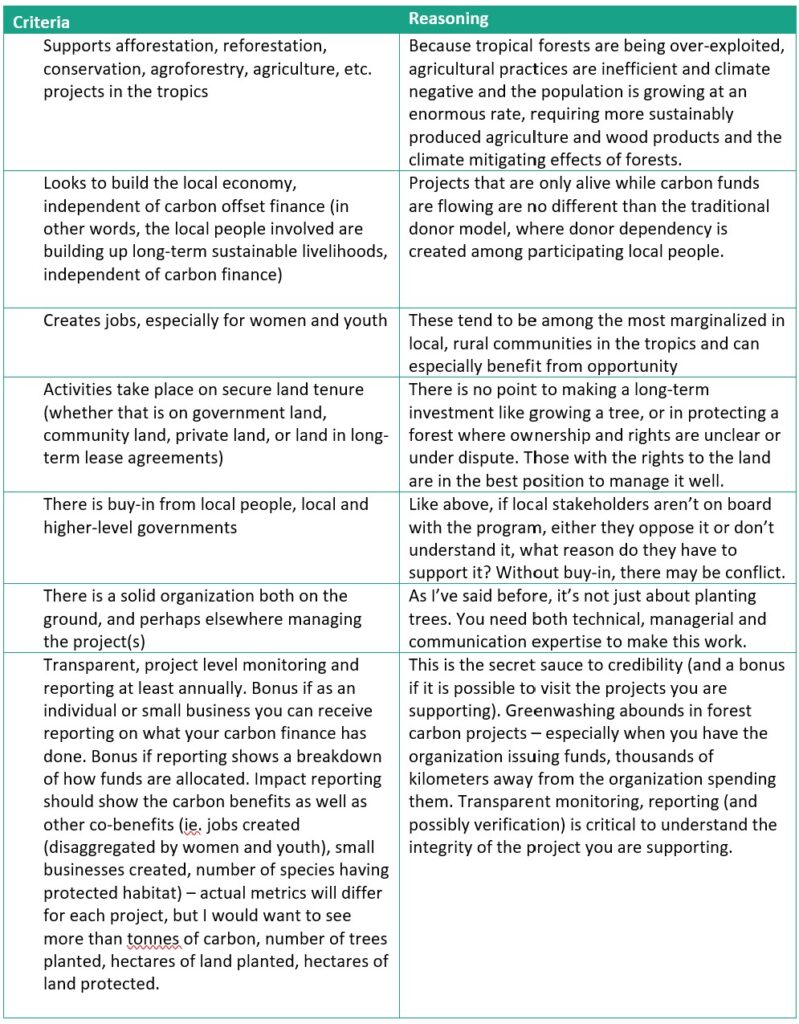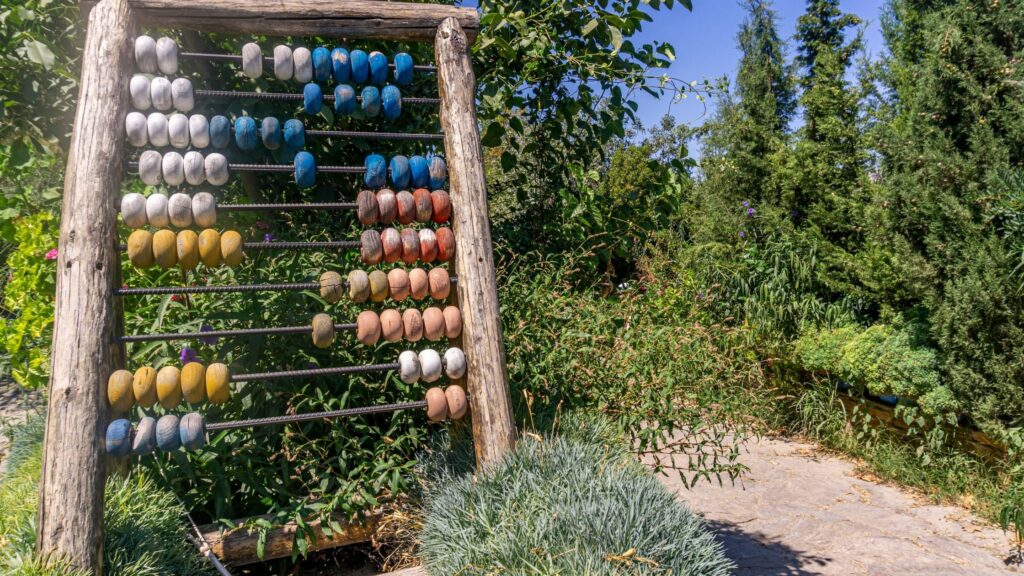It’s a bit ironic that a large part of my professional work is related to developing credible forest carbon projects in the tropics, yet I have not taken the steps personally to balance my own carbon footprint. Sure, whenever I fly, I check the box to offset my flight, or online purchases – but what is that €1.50 actually doing anyway? I also get excited about products that plant trees when you make a purchase (see this article, where I talk about exactly this), but again – is this a marketing stunt, or are they just putting trees in the ground and walking away? Are there better options available?
As I start to look at travelling again for work, and heading into the high-consuming holiday season, I thought it was high time I practice what I preach and offset my own carbon footprint. I know I’m not alone on this one, so I hope you will also benefit from this “desk-top” due diligence or initial screening of easy to access offset platforms.
Credible offset options for individuals and small businesses
Now, if you or your small business are going to go the extra mile to offset your emissions – beyond ticking the €1.50 contribution box before you proceed to checkout, you should do your research. You want to make sure that you are getting what you pay for, and that you are not contributing to some greenwashing campaign, or mis-managed project. Now, I haven’t gone to the next step of contacting the organizations I’m about to share with you to dig deeper into their process. However, I am going to present you a short list of forest carbon offset programs that appear credible according to my lengthy list of initial selection criteria. If you share the same concern as me regarding the importance of sustainable forest management in the tropics (including all things commercial reforestation, natural forest protection, community agroforestry, and so on), then this might just be the list for you. I encourage you to take the extra step and contact these organizations to judge for yourself if they put your money where their mouth is.
My screening criteria for assessing credibility
Now, I have the benefit of having seen firsthand what kinds of forest projects linked to sustainable development succeed over the long-run, and what are key elements of their success or failure. If I can impart one part of wisdom with you here today (and my colleagues in the sector will already know this, so humor me), a program that emphasizes number of trees planted, or trees protected for that matter is not what you should focus on. Of course, this is an important activity that will generate carbon sequestration or avoided emissions and can lead to a snowball of positive environmental and social benefits – however, it is not just about putting a tree in the ground. That tree needs to come from a good nursery, the species needs to be well suited to the site, it needs to be planted and managed according to a silvicultural regime that will allow its values to be realized, it needs to survive. This is but one example, where to the untrained eye, you can be lured into a beautiful picture of a local person planting a tree, only to have your funds (if they ever make it to the ground) plant the wrong tree, poorly, and it dies before it makes it to its second year. Okay, enough banter, let’s get on with my criteria, and why I have chosen them:

So, without further ado, let’s see how some common offset programs suitable for individuals or small companies perform when held to my strict criteria.
Offset Programs assessed
Offset Scheme 1: Stand For Trees
Description:
- Crowdfunded forest protection for individuals
- Individuals can buy a certificate and the money is donated to a Stand For Trees project.
- Stand For Trees uses the REDD+ conservation model.
- Stand For Trees Certificates are measurable, verified, high-quality carbon credits derived from avoided emissions by protecting a specific endangered forest. Each certificate represents measurable impacts for climate, communities, and biodiversity.
- Individuals can calculate their carbon footprint on the website
Region: West Africa, Central Africa, East Africa, Asia-Pacific, Brazil, Latin America
| Criteria: | Criteria Met? |
| Forest Carbon activity sponsored: | Conservation |
| Economically viable without carbon finance? | Yes |
| Job Creation? | Unclear |
| Secure land tenure? | Yes |
| Project buy-in? | Unclear |
| Strong management? | Yes |
| Transparent reporting? | No |
| Possibility to visit? | Unclear |
Offset Scheme 2: Native
Description:
- Individuals and companies can buy offsets as a one-off, quarterly, monthly, or on an annual basis.
- Donations will support their current project, or if several are underway you will be able to select the project you want to support.
- The current project supported is REDD in the Yaeda Valley, Tanzania (Plan Vivo standard). The aim of the project is to reduce emissions from deforestation.
- Each of their supported projects is certified by one of several third-party organizations, such as Gold Standard, Verified Carbon Standard, Climate Action Reserve, American Carbon Registry, Plan Vivo, Climate, and Community & Biodiversity Alliance.
- Individuals can calculate their carbon footprint on the website
Region: East Africa
| Criteria | Criteria Met? |
| Forest Carbon activity sponsored: | Conservation |
| Economically viable without carbon finance? | Yes |
| Job creation? | Yes |
| Secure land tenure? | Yes |
| Project buy-in? | Yes |
| Strong management? | Unclear |
| Transparent reporting? | Unclear |
| Possibility to visit? | Unclear |
Offset Scheme 3: Clear
Description:
- Carbon offsetting for individuals and businesses. Individuals can choose a one-off direct carbon offset amount or select to offset a flight, their car, home, internet, hotel stay etc. by using the carbon footprint calculator
- The carbon offsets purchased support a variety of projects including a Brazilian Rosewood Amazon Conservation VCS REDD project.
- Each of the projects meet certification standards, and all carbon offsets are certified by the Quality Assurance Standard for Carbon Offsetting.
Region: Brazil
| Criteria | Criteria Met? |
| Forest Carbon activity sponsored: | Conservation |
| Economically viable without carbon finance? | Yes |
| Job creation? | Yes |
| Secure land tenure? | Unclear |
| Project buy-in? | Yes |
| Strong management? | Unclear |
| Transparent reporting? | Unclear |
| Possibility to visit? | Unclear |
Offset Scheme 4: Treepoints
Description:
- Individuals and businesses can calculate their carbon footprint and then choose either a one-off payment or one of three monthly subscriptions (offsetting 3 – 9 tonnes of carbon per year).
- Individuals can track their impact, review the progress of projects and earn rewards to use with Treepoints’ eco-friendly partners.
- Contributions are spread across all projects so you cannot choose a specific project.
- Treepoints supports the Eden Reforestation Projects, and Carbon offsetting in Panama by introducing sustainable timber production and reforesting degraded pastureland with a mix of native tree species.
- This project is certified to the highest level by Gold Standard and meets at least three of the UN’s Sustainable Development Goals.
- You can view Treepoints’ public ledger online.
Region: Panama, Central America
| Criteria | Criteria Met? |
| Forest Carbon activity sponsored: | Conservation and Reforestation |
| Economically viable without carbon finance? | Yes |
| Job creation? | Yes |
| Secure land tenure? | Unclear |
| Project buy-in? | Yes |
| Strong management? | Unclear |
| Transparent reporting? | Impact Registry |
| Possibility to visit? | Unclear |
Offset Scheme 5: MyClimate
Description:
- Individuals and businesses can calculate and offset their carbon footprint. MyClimate projects meet the highest standards (Gold Standard, Plan Vivo), which reduce greenhouse gases locally and regionally, but also make a positive contribution to sustainable development.
- Individuals can choose to support a specific project or support all projects with their payment.
- MyClimate supports several projects, one of which is in the Solomon Islands.
- This conservation project avoids deforestation of intact rainforest by promoting alternative livelihood opportunities. In addition to avoided emissions and biodiversity protection, the project promotes Women’s Savings Clubs.
- This project is certified under Plan Vivo and contributes to 9 of the UN SDGs.
Region: Babatana Area, South-West Choiseul, Choiseul Province, Solomon Islands
| Criteria | Criteria Met? |
| Forest Carbon activity sponsored: | Conservation |
| Economically viable without carbon finance? | Yes |
| Job creation? | Yes |
| Secure land tenure? | Yes |
| Project buy-in? | Yes |
| Strong management? | Unclear |
| Transparent reporting? | Annual Reports Solomon Island Project Report (see page 144) |
| Possibility to visit? | Unclear |
Now, when digging into these platforms, there are some aspects that I really don’t like. Slandering logging is never something I support. Of course, illegal or unsustainable logging is not acceptable, but generalized statements against wood harvesting, in my view is discrediting to an offset program. I also notice that most projects are conservation focused. This is interesting when compared to a lot of retail projects, like those I mentioned in my previous article, that conversely plant trees. Both approaches are important, and as I indicated previously, the more important aspect is that they actually do what they say.
Before you are convinced by a project or offset platform’s photos and narratives used for marketing these projects, I encourage you to dig a bit deeper. Give them a call, ask them who the local managers are, how the local people will be self-reliant once carbon finance has stopped, and ask them if you can visit the project. A few questions will help you understand how closely they are actually involved in this project, or if your funds are paying for multiple layers of administration.
Personally, reviewing these platforms has not made choosing a personal offset scheme easier for me, but it has pointed me to the questions I need to ask. I hope this has given you something to think about. If you need support in designing criteria for your organization’s forest carbon offset program, please reach out.






